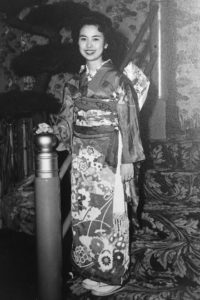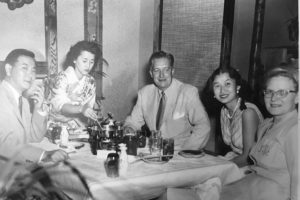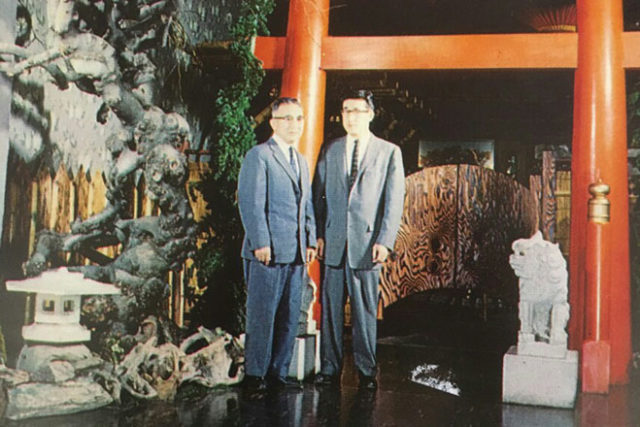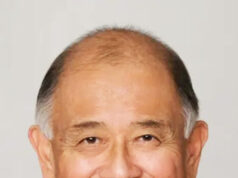By David Yamaguchi
The North American Post
On Saturday, June 18, I joined the friends, former employees, and family gathered at the Japanese Community and Cultural Center to hear Joan Seko speak on her 47 years as a co-owner/manager of Bush Garden Restaurant. All present recognized the significance of Mrs. Seko’s talk. It was an event marking the end of another Seattle Nikkei community institution, much like the recent closure of Imperial Lanes in the Rainier Valley.
Mrs. Seko began by describing her family, the Morishimas. Notably, her parents had brought her to Japan at age four to visit her ailing grandmother when they received warning that war was imminent. If they wanted to return to the US, they needed to do so as soon as possible. As luck would have it, they boarded the last ship to successfully leave Japan for the United States. The young Joan came home to watch herself walking down the gangplank on movie newsreels. (See Mrs. Seko’s article, “The Last Boat Out” in the March 3 issue of this paper.)
A member of the Garfield High class of 1955, Mrs. Seko met her future husband Roy when they were on separate dates at the Palladium Ballroom (formerly at N. 125th and Aurora).
The restaurant came into the picture when her father-in-law, Kaichi Seko, who had run the original Bush Garden Restaurant in the Bush Hotel (1953-1956), asked her and Roy if they wanted to open a new Bush Garden Restaurant with him. The wedding reception for Joan and Roy would turn out to be the first party at the new location.
The new restaurant was lavish. Rated for a capacity of 450 people, it had 40 tatami rooms. Notably, there were rectangular wells under the tables for customers’ legs. This was an invention of her father-in-law, as standard flat tatami mats would be too uncomfortable for Americans.
Roy Seko went on to build additional Bush Garden restaurants. A second was in Portland, Oregon (1960). A third was in San Francisco (in the Victoria Hotel, 1961).
The name of the restaurant was perplexing. Many thought it was named after the Bush Hotel. In fact it comes from the Chinese reading of the kanji for samurai. [Bushido, the way of the samurai, has become an English word.]
The restaurant employed 23 “international brides” (Mrs. Seko dislikes the term “war bride”) and eight Nisei waitresses. Bus boys and girls came from Franklin and Cleveland High at 75c an hour (minimum wage at the time).
For the first ten years, the Sekos lived on the third floor of the restaurant. While that arrangement eliminated commuting from their busy lives, the downside was that there were few children in the neighborhood for their children to play with. They would have five.
As an “experience” restaurant, many a celebrity came to dine over the years, including baseball player Joe DiMaggio (famous for marrying Marilyn Monroe); Cicely Tyson (an actress in “Roots”); Misora Hibari (the singer known for “Kawa no nagare no you ni” [Like a flowing river]; 448,000 views on YouTube!); and a former Seattle mayor (pictured).
President Nixon also wanted to come, but his Secret Service men nixed it on an advance visit.
“There were too many hidden crannies.”
Mrs. Seko shared some funny stories. One was that “there was a lot of hanky-panky in the restaurant.” In the most memorable instance, a waitress entered a tatami room to find the sukiyaki boiling, but the guests not in sight (they were under the table!).
“What should I do?,” the waitress asked Mrs. Seko, who replied that she should just turn off the burner and leave the guests alone. Afterwards, the Sekos removed one shoji door from each room, so the rooms were no longer so private.
There was another time when a robber came in to steal from Mrs. Seko at the front cash register, when she was nine months pregnant (with her son Gregg).
“I would never hurt a mother,” the robber said.
“You’re too late—the night’s receipts have already gone to the bank,” Mrs. Seko had said. (In fact, she had dropped the bills from the register into the wastepaper basket.) She gave him the $50 in change left in the till and he was out the door.
A third story is that the third floor of the restaurant was rumored to be haunted. Employees saw shadows…
During the informal discussion following Mrs. Seko’s talk, former bus-girl Mary Abo—then a UW student from Juneau—remembered Bush Garden as “the nicest restaurant in Seattle.” She recalled “the nice Japanese dinners for the workers,” and the waitresses sharing tips with the bus staff.
A former waitress, Shizue Billedo, had tears in her eyes. She showed me her picture as a Bush Garden waitress. She worked there for 40 years.
In recent years, the restaurant had been rented by Masaharu Sakata with wife Karen Akada-Sakata. Under the Sakatas, Bush Garden won “Best Karaoke” in the reader poll of the June 15th International Examiner.
In recent weeks, friends have been helping the Sekos remove keepsakes including the sliding doors and intricately carved wooden wall panels.
“When the restaurant is destroyed, people won’t know it,” Mrs. Seko said.

Photos courtesy of Joan Seko









